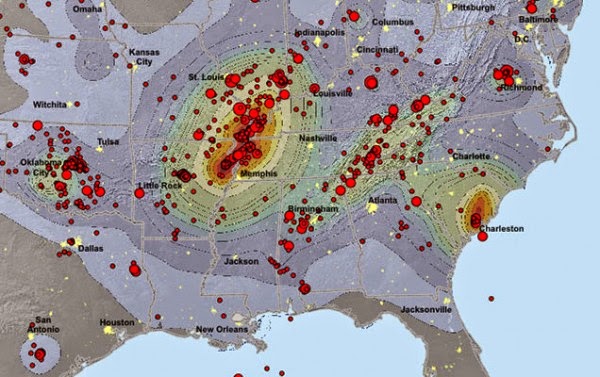
The occasional quakes rattling the New Madrid Seismic Zone, a series of midwestern faults named for a small town in the Missouri Bootheel, aren’t aftershocks of the massive quakes that rocked our fledgling nation more than 2 centuries ago, a new study suggests. The analysis reinvigorates a debate about the true level of seismic risk that those fault zones pose.
In the winter of 1811 to 1812, a series of colossal quakes—by some estimates among the strongest ever seen in what is today the continental United States—exploded beneath what is now the American Midwest. In a span of less than 2 months, four magnitude-7 or greater temblors struck along a zigzag set of faults centered near the river town of New Madrid, Missouri, the closest settlement to the destruction. Although the quakes were felt as far away as the East Coast, the area around the quake was sparsely populated, so devastation was limited. (The Greater St. Louis area, home to about 2.9 million people today but less than 6000 at the time the quakes occurred, is centered about 235 kilometers north of New Madrid.)
As with all major quakes, the New Madrid quakes spawned a lot of aftershocks, says Morgan Page, a geophysicist with the U.S. Geological Survey (USGS) in Pasadena, California. Indeed, one of the four largest quakes of that winter—one that occurred at about dawn on 16 December 1811—is considered to be an aftershock of the first quake in the series, which occurred about 5 hours earlier. One of seismology’s biggest debates, which bears on the amount of seismic risk in the area today, is how long those aftershocks continued. Some studies suggest that they’re still going on, which would support those who argue there is little chance of major quakes striking New Madrid in coming centuries.
A new analysis by Page and USGS colleague Susan Hough indicates that modern-day rumblings in the New Madrid Seismic Zone are not echoes of the 1811 to 1812 quakes, however. Instead, they are signs the seismic zone is still alive and kicking. The team’s analysis uses a model that simulates how series of aftershocks unfold—statistics that were first described by a Japanese seismologist in the 1890s. (According to that model, the number and size of aftershocks generally decrease over time in a predictable way.)
For the new study, Page and Hough considered three sets of data: the number and size of the original set of quakes, the number and spacing of magnitude-6 or larger aftershocks recorded in the years after the original group of temblors, and the number and size of magnitude-4 or larger quakes recorded by seismometers in the region today. Results of the team’s statistical analysis suggest that the long-verified, more-than-a-century-old model doesn’t fit the pattern of seismicity seen on the New Madrid Seismic Zone in the past 2 centuries, the researchers report online today in Science.
Specifically, the team found that if today’s magnitude-4 or larger quakes were truly aftershocks of the 1811 to 1812 quakes, then scientists should have seen about 135 magnitude-6 or larger temblors between 1812 and 2012. In fact, Page says, only two such quakes occurred. Conversely, a series of aftershocks that contains only two such moderate-sized aftershocks would also contain far fewer magnitude-4 or larger quakes than sensors actually record today. In other words, modern-day quakes are signs that the faults in the region are still accumulating stress—and sometimes releasing it as fresh rumblings.
But some scientists don’t find the team’s results convincing. For example, aftershock sequences for quakes that occur at faults far from a tectonic plate boundary—such as the New Madrid Seismic Zone—often last much longer than those triggered by quakes near plate boundaries, says Seth Stein, a geophysicist at Northwestern University in Evanston, Illinois. Because those faults behave differently, he contends, the new study doesn’t show that modern-day quakes aren’t aftershocks.
Stein and Mian Liu, a geophysicist at the University of Missouri, Columbia, find that GPS equipment installed throughout the region has failed to detect strain building up in Earth’s crust that would be required to trigger fresh quakes. That would suggest that the New Madrid threat is not growing, but the source of seismic stress in the region, far from any boundaries where tectonic plates jostle and scrape past each other, isn’t clear. Some scientists have argued that Earth’s crust in northern portions of North America is still slowly springing upward in response to the melting of the ice sheet that smothered the region during the last ice age. As that rebound slows, so should the buildup of stress in the crust underlying the Midwest, they say. For this reason, Stein and other scientists have in the past suggested that the New Madrid Seismic Zone is gradually dying.
But previous studies don’t show seismicity in the region to be slowing down, at least over the very long term. Indeed, groups of major quakes strike the New Madrid Seismic Zone with some regularity, Page says. Geologic evidence shows that other clusters of large quakes rumbled the region around 900 A.D. and around 1450, she notes. But that recent seismic history doesn’t help predict when the next set of “big ones” will occur, or how large they’ll be. “These things don’t go off on a regular basis,” she adds.
Based on previous analyses, USGS scientists have estimated the chance of having an earthquake similar to one of the 1811 to 1812 temblors in the next 50 years is about 7% to 10%, and the chance of having a magnitude-6 or larger earthquake in the next 50 years is 25% to 40%.
Note : The above story is based on materials provided by Sid Perkins ” American Association for the Advancement of Science “










